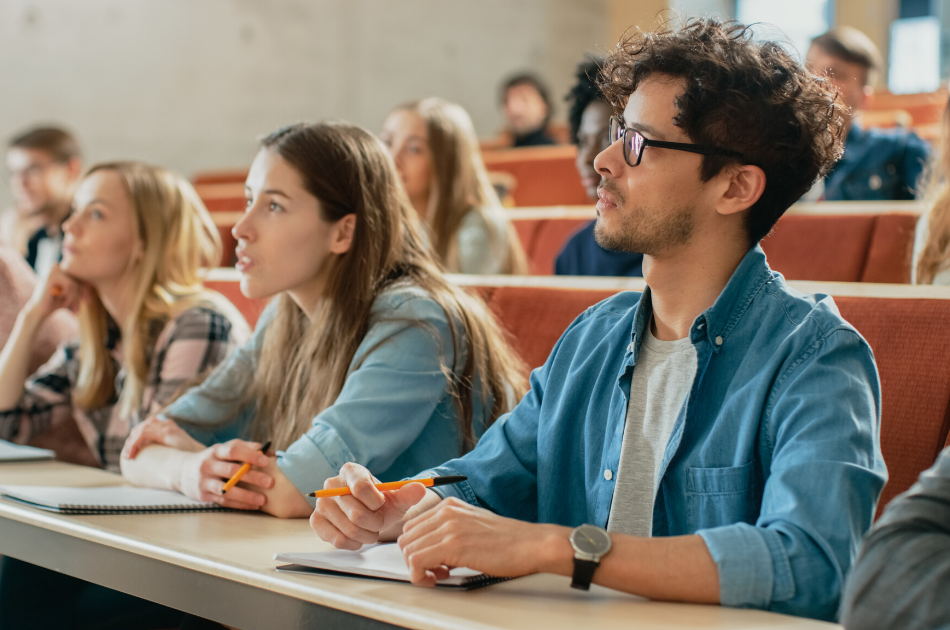University educators increasingly see the value of active learning initiatives—activities that engage students in the learning process as opposed to passive learning such as sitting in a lecture hall and taking notes. “Both types of learning have their role in a college setting,” says Mounira Morris, PhD, assistant teaching professor and faculty director for Northeastern’s higher education programs, “However, I’m a proponent of active learning because it gives students a chance to develop higher-order critical thinking and analysis skills.”
There are many ways educators can pique students’ interest in a topic, foster a sense of camaraderie between students, and enhance students’ understanding of the subject matter. Read on to learn more about active learning, including its benefits and actionable strategies to help utilize active learning in your organization.
Download Our Free Guide to Advancing in Higher Education
Learn more about how you can change the course of higher education—from the skills you need to the different roles available.
What is Active Learning?
Active learning requires students to engage in meaningful activities and think deeply about the concepts they’re learning. When students engage in active learning—such as working together to apply a new practice— they are more likely to retain what they’ve learned.
A wide number of exercises are considered active learning strategies, including:
- Debating a current event
- Engaging in case studies or simulations
- Actively self-monitoring their learning
- Constructing a quiz for use with peers
- Reflecting on a topic covered in class
- Interviewing experts in their field
What are the Benefits of Active Learning?
Morris notes that there are many benefits of active learning, including:
- Helping students deepen their understanding of a given topic
- Giving professors insight into how well students are grasping new concepts
- Building connections between students, which has also been shown to increase course completion rates
Numerous research studies have shown that active learning instructional strategies are twice as effective at providing a conceptual understanding of subject matter than traditional methods, particularly increasing students’ performance in science, engineering, math, and technology. These practices also have been beneficial for decreasing the achievement gap for underrepresented and first-generation college students.
Additionally, research conducted by the National Academy of Sciences revealed that students in classes with traditional lecturing were 1.5 times more likely to fail than students in classes who participated in active learning activities. “Students have a real thirst for learning,” says Morris. “There is higher engagement with active learning than if we just give a lecture. I find that students want to absorb more and follow up. They reach out to me to have a dialogue to enrich their understanding of what they are learning.”
Where is Active Learning Used?
Active learning activities are incorporated into many disciplines in college and university courses as well as in K-12 classes. “The goal is to have students actively applying what they learned in class,” explains Morris. “They might facilitate a discussion with a small group of classmates or be assigned a case study where they’re working together in a small group to solve a particular problem”.
Reflection is also an important element in active learning. “[Master’s in Higher Education Administration] students learn the various student development theories but they might not know how to apply this knowledge to their own work,” says Morris. “I always encourage my students to reflect on what they learned in class. This opportunity gives them the space to think about the course material and how they want to implement what they learned at their current institution. This—along with discussions with their peers—can often show them another way to think about their learning.”
Real Examples of Active Learning in Higher Education
Group projects, including case studies, allow students to learn from one another. “I’m a huge fan of case studies,” says Morris. “Students can learn through real-world situational problem-solving.”
This type of experiential learning is part of the culture at Northeastern University. This practice enables students to put ideas into action in a real, professional setting. Faculty members are heavily engaged in this process, serving as guides as students work to solve real-world problems.
For example, Morris piloted a project where four Master’s of Higher Education Administration students served as consultants to a vice president of Student Affairs for a small institution. The vice president shared a pressing issue facing her institution. The students met with the vice president to gather data, interviewed campus stakeholders, studied institutions facing similar issues, and researched student development theory to support their work. The students then provided short- and long-term recommendations to the institution and presented their findings to the vice president, her students, and colleagues. They followed this up with a 25-page written analysis of the situation.
“I wanted my students to learn how to present their analysis and recommendations to senior-level administrators, which promotes higher-order thinking,” says Morris. “Afterward, the students said this experience was the highlight of their degree program. Now they can apply the theories they learned to practice. The vice president loved it too! She is hoping to implement one of the students’ recommendations. More importantly, the students built a network with the vice president of Student Affairs and with each other, so the benefits expanded beyond the course.”
Advice for Educators
Not all active learning exercises are appropriate for all courses or for all students. Educators should select activities that are aligned with the learning outcomes they’re seeking.
Setting up students to work in pairs or groups of three or four is often helpful with active learning exercises. “We’re always looking for ways for students to interact versus just posting responses on a discussion board,” Morris says. “I often form small group projects within my courses. Some students initially cringe when they see the assignment, but they end up enjoying it because it’s a chance to interact with their fellow learners outside of a discussion board. They learn from each other’s professional experiences and can interact in real-time.”
Ultimately, these active learning exercises create meaningful ways for students to apply knowledge in their own professional spaces.
Are you interested in learning more about applying active learning strategies in your work? Download our free ebook below to learn how a Master’s in Higher Education Administration can help you make a difference.







Related Articles
What is Learning Analytics & How Can it Be Used?
Reasons To Enroll in a Doctor of Education Program
Why I Chose to Pursue Learning Analytics